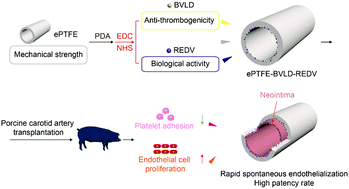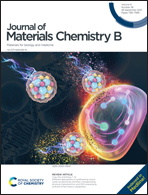Vascular transplantation with dual-biofunctional ePTFE vascular grafts in a porcine model†
Abstract
Cardiovascular disease (CVD) poses serious health concerns worldwide. The lack of transplantable vascular grafts is an unmet clinical need in the surgical treatment of CVD. Although expanded polytetrafluoroethylene (ePTFE) vascular grafts have been used in clinical practice, a low long-term patency rate in small-diameter transplantation application is still the biggest challenge. Thus, surface modification of ePTFE is sought after. In this study, polydopamine (PDA) was used to improve the hydrophilia and provide immobilization sites in ePTFE. Bivalirudin (BVLD), a direct thrombin inhibitor, was used to enhance the anti-thrombotic activity of ePTFE. The peptides derived from extracellular matrix proteins were used to elevate the bioactivity of ePTFE. The morphology, chemical composition, peptide modified strength, wettability, and hemocompatibility of modified ePTFE vascular grafts were investigated. Then, an endothelial cell proliferation assay was used to evaluate the best co-modification strategy of the ePTFE vascular graft in vitro. Since a large animal could relatively better mimic human physiology, we chose a porcine carotid artery replacement model in the current study. The results showed that the BVLD/REDV co-modified ePTFE vascular grafts had a satisfactory patency rate (66.7%) and a higher endothelial cell coverage ratio (70%) at 12 weeks after implantation. This may offer an opportunity to produce a multi-biofunctional ePTFE vascular graft, thereby yielding a potent product to meet the clinical needs.



 Please wait while we load your content...
Please wait while we load your content...